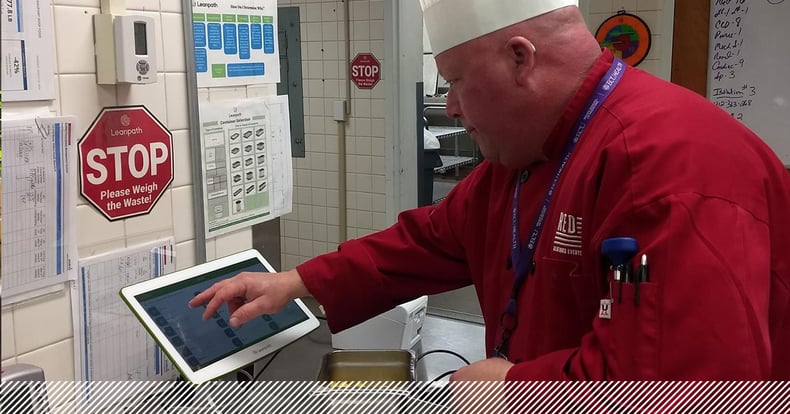How this Sodexo healthcare site cut its plate waste and gained insight into service efficiency

East Carolina University Medical Center’s Beaufort Hospital is a 142-bed healthcare campus in Washington, North Carolina, USA. Food and nutrition services are operated by Sodexo and overseen by General Manager Denise M. Hewitt and Executive Chef John Jacob Phillips (above at his Leanpath Tracker).
The team has successfully reduced its kitchen waste by 53 percent since implementing the Leanpath program in 2020. Expanding on that success, beginning in 2023, they started using their program to track plate waste from patient trays, and within months they have seen a reduction in plate waste of 24 percent.
“It’s about managing the whole flow of food through the kitchen,” says Chef John. “Understanding purchasing, to storage, to utilization, and ultimately to what exactly is being wasted and getting that information back to the employees.”
“Food waste represents dollars wasted, and we have to be good fiduciary stewards,” adds Denise. There is also a nutritional concern with plate waste. “If our patients are not eating, we run the risk of them not being healed through food. We do not want them to develop other nutritional issues that compound their health problems. That's why we chose to focus on our patient plate waste.”
At the end of each meal period, foodservice aides collect patient trays from each floor and return them to the kitchen, where the plates are scraped into clear lexan containers, spot checked, and tracked with Leanpath. Spot checking allows them to identify any commonly wasted items from each meal period.
“It’s kitchen operations 101,” says Chef John. “You always want to see what’s coming back. Is there a problem with the food preparation or portions? What are their likes and dislikes? It gives you a lot of information.”
Through their tracking, food waste trends started to emerge. Leanpath data quickly revealed that breakfast was their highest waste period of the day. After conversations with foodservice aides and patients, the source of the waste became apparent.
“Breakfast orders are taken the day prior,” explains Denise. “Patients may feel good when they give their breakfast order, but when they wake up in the morning, if they slept at all, and depending on their medications, they may decide they only want oatmeal. So that meal ends up as waste.”
They are working to identify the best time to take orders that also allows for adequate prep time.
Another plate waste trend–the high amount of wasted beverages–brought to light a retraining opportunity on their meal ordering system, which requires unchecking beverages that should not be included.
“The patient probably doesn’t want milk, juice, coffee, water, tea, but because it’s on the ticket we have to send it. We have done retraining on the system and talk about this in our daily huddles.”
Another trend pointed to the need for an adjustment to service.
“For speed of service, we were putting all condiments in a small personal container and setting it on the patient tray,” Denise says. “Once everything goes to the patient, when it comes back it has to be thrown away and we were seeing a lot of condiment waste. So now condiments are upon request.”
The work at Beaufort to reduce waste is a part of a larger ethic the team practices.
“What we do here from a waste perspective, we live it,” says Denise. “We want our team to take everything we teach them back to their homes and communities. We hope to teach them to be better stewards of resources, and the Earth, and food, and themselves. It takes a village.”